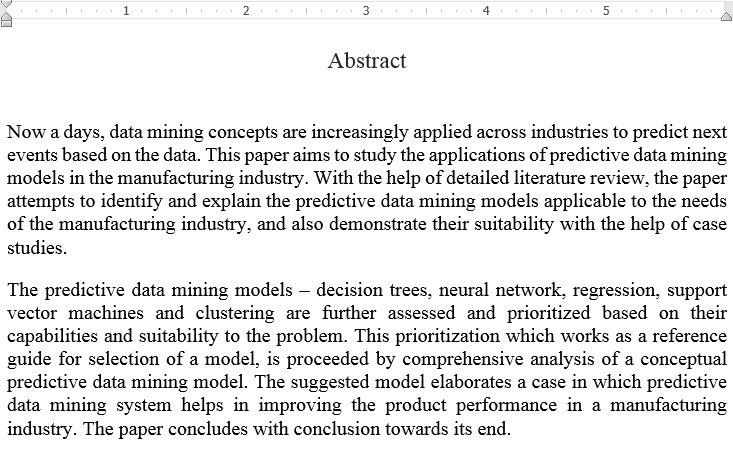MMIS 643 Data Mining Class Project Paper on Predictive Models Used in Manufacturing Industry for Data Mining
Data Mining Class Project Paper on Predictive Models Used in Manufacturing Industry for Data Mining
In this project, you will be expected to do a comprehensive literature search and survey, select and study a specific topic in one subject area of data mining and its applications in business intelligence and analytics (BIA), and write a research paper on the selected topic by yourself. The research paper you are required to write can be a detailed comprehensive study on some specific topic or the original research work that will have been done by yourself.
Requirements and Instructions for the Research Paper:
1. The objective of the paper should be very clear about subject, scope, domain, and the goals to be achieved.
2. The paper should address the important advanced and critical issues in a specific area of data mining and its applications in business intelligence and analytics. Your research paper should emphasize not only breadth of coverage, but also depth of coverage in the specific area.
3. The research paper should give the measurable conclusions and future research directions (this is your contribution).
4. It might be beneficial to review or browse through about 20 to 30 relevant technical articles before you make decision on the topic of the research project.
5. The research paper can be:
a. Literature review papers on data mining techniques and its applications for business intelligence and analytics.
b. Study and examination of data mining techniques in depth with technical details.
c. Applied research that applies a data mining method to solve a real world application in terms of the domain of BIA.
6. The research paper should reflect the quality at certain academic research level.
7. The paper should be about at least 3000-3500 words.
8. The paper should include adequate abstraction or introduction, and reference list.
9. Please write the paper in your words and statements, and please give the names of references, citations, and resources of reference materials if you want to use the statements from other reference articles.
10. From the systematic study point of view, you may want to read a list of technical papers from relevant magazines, journals, conference proceedings and theses in the area of the topic you choose.
11. For the format and style of your research paper, please make reference to CEC Dissertation Guide (http://cec.nova.edu/documents/diss_guide.pdf), Publication Manual of APA, or the format of ACM and IEEE journal publications. Suggested and Possible Topics for Written Report (But Not Limited)
Supervised Learning Methods:
Classification Methods:
Regression Methods
Multiple Linear Regression
Logistic Regression
Ordered Logistic And Ordered Probit Regression Models
Multinomial Logistic Regression Model
Poisson and Negative Binomial Regression Models
Bayesian Classification
Naïve Bayes Method
k Nearest Neighbors
Decision Trees
ID3 (Iterative Dichotomiser 3)
C4.5 and C5.0
CART (Classification and Regression Trees)
Scalable Decision Tree Techniques
Neural Network-Based Methods
Back Propagation
Neural Network Supervised Learning
Bayes Belief Network
Rule-Based Methods
Generating Rules from a Decision Tree
Generating Rules from a Neural Net
Generating Rules without Decision Tree or Neural Net
Support Vector Machine
Fuzzy Set and Rough Set Methods
Unsupervised Learning Methods:
Clustering Methods:
Partition Based Methods
Squared Error Clustering
K-Means Clustering (Centroid-Based Technique)
K-Medoids Method (Partition Around Medoids, Representative Object-Based Technique)
Bond Energy
Hierarchical Methods
Agnes(Agglomerative vs. Divisive Hierarchical Clustering)
BIRCH (Balanced Iterative Reducing and Clustering Using Hierarchies)
Chameleon (Hierarchical Clustering using Dynamic Modeling)
CLARANS (Clustering Large Applications Based Upon Randomized Search)
CURE (Clustering Using REpresentatives)
Density Based Methods
DBSCAN (Density Based Spatial Clustering of Applications with Noise, Density Based
Clustering Based on Connected Regions with High Density)
OPTICS (Ordering Points to Identity the Clustering Structure)
DENCLUE (DENsity Based CLUstEring, Clustering Based on Density Distribution Functions)
Grid-Based Methods
STING (Statistical Information Grid)
CLIQUE (Clustering In QUEst, An Apriori-like Subspace Clustering Method)
Probabilistic Model Based Clustering
Clustering Graph and Network Data (For Example, Social Networks)
Self-Organized Map Technique
Evaluation and Performance Measurement of Clustering Methods
Assessing Clustering Technology
Determining the Number of Clusters
Measuring Clustering Quality
Association Rule Mining
Evolution Based Methods:
Genetic Algorithms
Applications:
Data Mining Applications for Business Intelligence and Analytics
Text Mining
Spatial Mining
Temporal Mining
Web Mining
Others:
Over fitting and Under fitting issues
Outliers
Performance Evaluation and Measurement
Confusion Matrix
ROC (Receiver Operating Characteristic)
AUC (Area Under the Curve)
Data Mining Tools
XLMiner
RapdiMiner
Weka
NodeXL
- File Format: Microsoft Word Document .doc
- Total Number of Pages: 24
- Paper Format: APA Paper
- Any Figures Included: Yes
- Total Word Count: 4152 words
- Custom Solution Available: No

